The best budget telephoto lenses for Nikon cameras.
Telephoto lenses are notable for a narrow angle of view. They “enlarge” objects located at a distance, bringing them closer to the viewer. Such lenses feature a focal length longer than 105mm. Plenty of wildlife and sports photographers are actively using telephoto lenses.
Besides, they are used to take candid pictures of people standing far away, as well as for magnifying landscapes’ and cityscapes’ details that sometimes go unnoticeable when captured from a wider perspective.
In case you are a lucky owner of a Nikon camera, you will enjoy an array of compatible lenses presented on today’s market – from decent zoom ones with widest apertures to extreme telephoto zooms reaching 500mm.
In this review, I will cover the best telephoto lenses for Nikon, describe their characteristics and help you pick a perfect model for you.
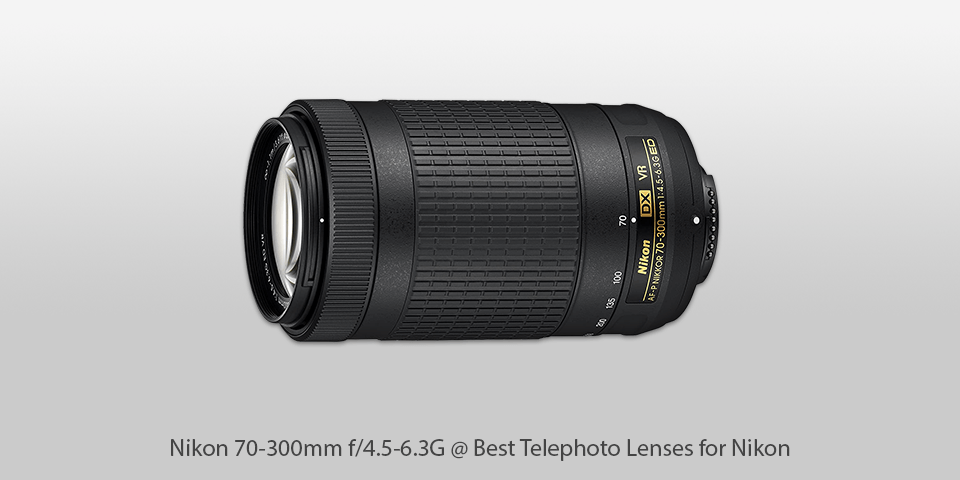
Mount: Nikon F | Diaphragm blades: 7 | Autofocus: Yes | Min focus distance: 1.1m | Max magnification: 0.22x | Filter thread: 58mm | Dimensions (WxL): 72 x 125mm | Weight: 415 g
⊕ Compact dimensions
⊕ Long telephoto range
⊕ Remarkable picture stabilization
⊕ Decent picture quality
⊖ Narrow aperture
⊖ Not suitable for manual focus
The AF-P DX Nikkor 70-300mm f/4.5-6.3G ED VR is a budget telephoto lens for Nikon DX-format SLRs. It boasts light weight, compact dimensions and produces qualitative shots unless you enable zooming to the full extent.
The model pleases users with remarkable optics and sophisticated technology found in Nikon’s premium lenses. With Nikon 70-300mm, pictures and footage will get vivid colors, profound contrast, insignificant distortion and stunning slightly blurred backgrounds even if the shooting conditions are less than perfect.
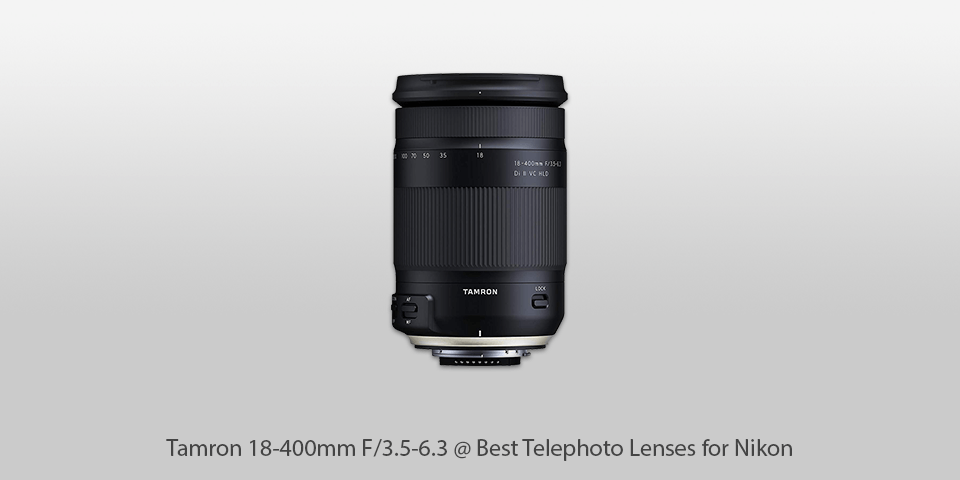
Mount: Nikon F | Diaphragm blades: 7 | Autofocus: Yes | Min focus distance: 0.45m | Max magnification: 0.34x | Filter thread: 72mm | Dimensions (WxL): 79 x 121.4mm | Weight: 705g
⊕ 22.2x zoom ratio
⊕ Superb picture quality
⊕ Picture stabilization
⊕ Waterproof design
⊖ Noticeable distortion
⊖ Rotation of focus ring during AF
Having a focal length range of 18-400mm and 22.2x zoom, this model offers an incredible telephoto range corresponding to 620mm in the 35mm format. The design of this Nikon tele lens is waterproof, so you can safely bring it with you to all sorts of trips.
The modern optical design comprises elements like an aspherical lens and LD glass. Besides, the lens keeps control of such issues as distortions and chromatic aberrations across the entire zoom range.
No matter if you photograph at telephoto or wide-angle – you are bound to get awesome shots with sufficient sharpness. Tele-macro photography is possible as well thanks to a maximum magnification ratio of 1:2.9.
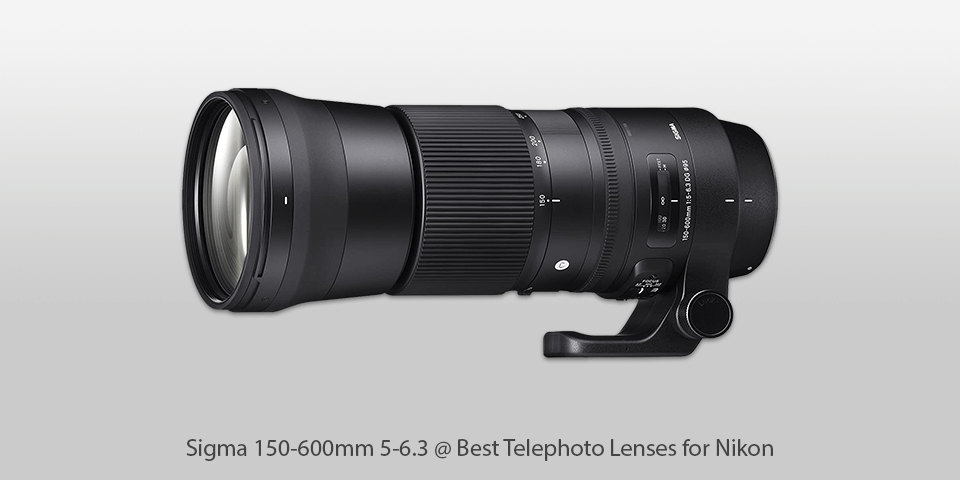
Mount: Nikon F | Diaphragm blades: 9 | Autofocus: Yes | Min focus distance: 2.8m | Max magnification: 0.2x | Filter thread: 95mm | Dimensions (WxL): 105 x 260.1mm | Weight: 1830 g
⊕ Incredible sharpness
⊕ Features tripod collar and lens hood
⊕ Swift focusing
⊕ Efficient picture stabilization system
⊖ Quite narrow aperture
⊖ Bulky
The Sigma 150-600mm f/5-6.3 DG OS HSM Contemporary is a large and bulky model. It is explained by the fact that the lens provides reliable construction, full-frame sensor coverage and maximum reach.
To achieve clear pictures while shooting handheld at slower shutter speeds and working with accommodating subjects, the model integrates an efficient picture stabilization system.
According to different tests, this zoom lens for Nikon offers sufficient sharpness and an insignificant amount of pincushion distortion and chromatic aberrations. It isn’t really a drawback for sports and wildlife photography (the lens is meant for these genres), especially if we consider its value for the money.
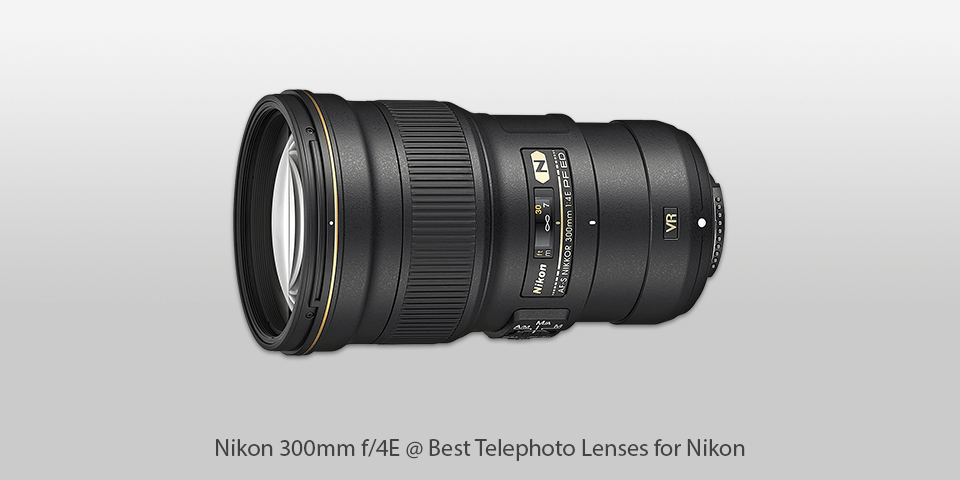
Mount: Nikon F | Diaphragm blades: 9 | Autofocus: Yes | Min focus distance: 1.4m | Max magnification: 024x | Filter thread: 77mm | Dimensions (WxL): 89 x 147.5mm| Weight: 755 g
⊕ Lightweight design
⊕ Sharp from edge to edge
⊕ Optically stabilized
⊕ 1:4 magnification
⊖ Expensive
⊖ No compatibility with cameras released a long time ago
The Nikon AF-S Nikkor 300mm f/4E PF ED VR has more compact dimensions and lighter weight than other long Nikon lenses covering a full-frame sensor. One of the most prominent characteristics of this model is a Phase Fresnel (PF) lens element.
It excels at producing amazing clarity and sharpness, free from any ghosting or chromatic aberrations. The lens is truly state-of-the-art, designed to unleash the potential of high-resolution full-frame cameras.
Extra-low Dispersion glass element and Nano Crystal Coat contribute to crisp and precise pictures produced by the camera. With Silent Wave Motor, you can expect practically noiseless and extremely swift autofocusing.
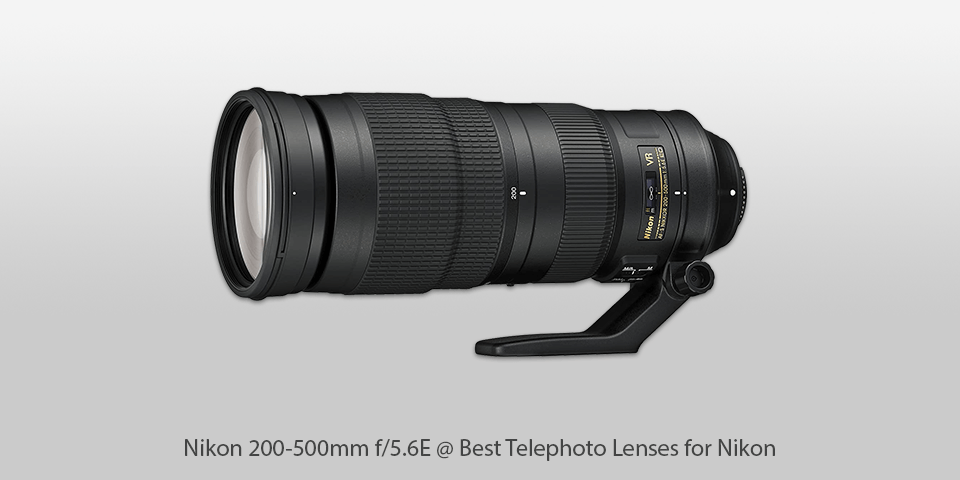
Mount: Nikon F | Diaphragm blades: 9 | Autofocus: Yes | Min focus distance: 2.2m | Max magnification: 0.22x | Filter thread: 95mm | Dimensions (WxL): 108x268mm | Weight: 2300g
⊕ Sharp optics
⊕ Long telephoto range
⊕ Fixed f/5.6 maximum aperture
⊕ Optical stabilization
⊕ Features detachable tripod collar
⊖ Zoom of analog models is larger
The AF-S Nikkor 200-500mm f/5.6E ED VR presents a combination of sharp optics and narrow aperture, without making the lens too heavy and overpriced. Moreover, it is even possible to magnify objects located at a distance of 7.2 feet to achieve nice macro shots.
Vibration Reduction picture stabilization offsets camera shake up to ~4.5 stops for shots with sufficient sharpness and videos with sufficient stability. Extra-low Dispersion (ED) glass helps you deal with the glare of bright daylight.
Silent Wave Motor (SWM) contributes to incredibly swift, almost noiseless autofocusing with excellent manual control. An electromagnetic diaphragm (E) works in tune with the fastest shutter speeds and frame rates, even if you decide to use a teleconverter. All these cool features make Nikon 200-500mm one of the best Nikon telephoto zoom lenses.
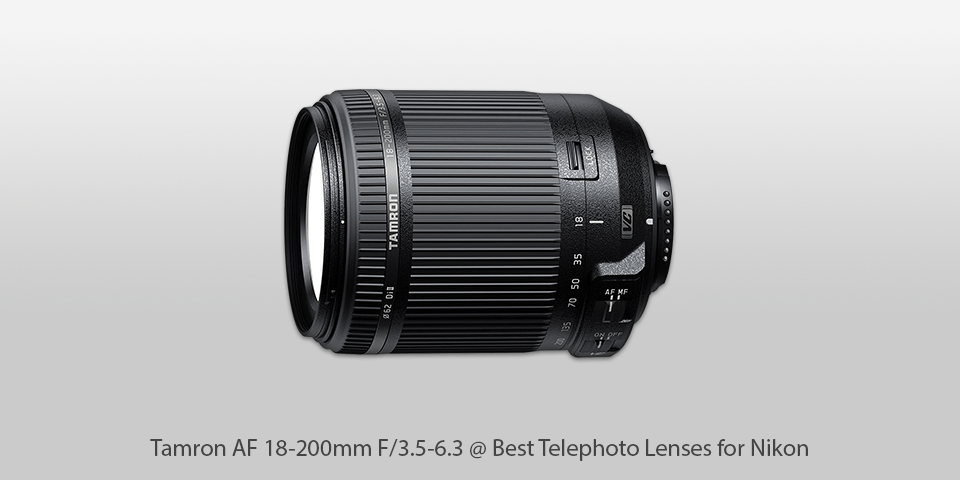
Mount: Nikon F | Diaphragm blades: 7 | Autofocus: Yes | Min focus distance: 0.49m | Max magnification: 0.25x | Filter thread: 62mm | Dimensions (WxL): 75 x 94.1mm | Weight: 400 g
⊕ 22.2x zoom ratio
⊕ Nice picture quality
⊕ Picture stabilization
⊕ Waterproof design
⊖ Noticeable distortion
⊖ Rotation of focus ring during AF
One of the notable characteristics of the Tamron 18-400mm f/3.5-6.3 Di II VC HLD is the coverage of an exceptional zoom range – from wide-angle to extreme telephoto. Although the models with shorter ratios win over in terms of picture quality, the Tamron AF 18-200mm is more convenient.
The 18-400mm is rather long, but it is compatible with the APS-C SLR cameras (as expected). The dimensions of this 400mm lens for Nikon are 4.9 by 3.1 inches (HD) in the shortest position. When zoomed, the size of the lens reaches approximately 9 inches.
The weight is quite large (1.6 pounds), with the support for 72mm front filters. The autofocus drive became less slow and noisy, which is done to help photographers achieve incredibly sharp shots. The Tamron VC picture stabilizer contributes to producing pictures without any blur.
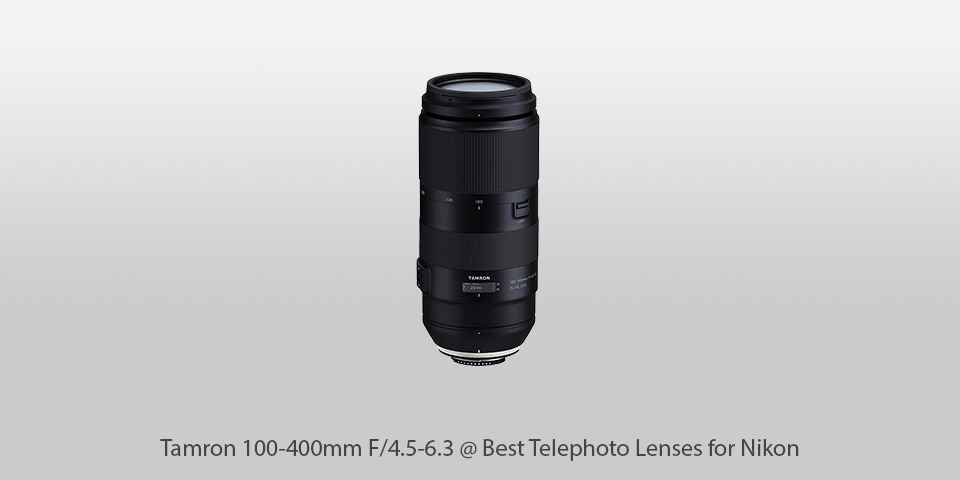
Mount: Nikon F | Diaphragm blades: 9 | Autofocus: Yes | Min focus distance: 1.5m | Max magnification: 0.28x | Filter thread: 67mm | Dimensions (WxL): 86.2 x 196.5mm | Weight: 1115 g
⊕ Long telephoto reach
⊕ Optical stabilization
⊕ Fluorine lens coat
⊕ Water- and dust-proof
⊖ Vignette at maximum aperture
⊖ Slight pincushion distortion
The Tamron 100-400mm F/4.5-6.3 Di VC USD is an ultra-telephoto zoom lens praised for compact dimensions and AF accuracy that helps you take crisp pictures straightaway. Due to the efficient incorporation and positioning of 3 LD glass elements, aberrations typical for telephoto lenses are eliminated.
Tamron’s proprietary eBAND coating protects from reflections, with the aim to produce clear and vibrant shots. Since a lens barrel is made mainly of magnesium at the chosen area, the Tamron 100-400mm is the most lightweight Nikon long zoom lens among the ultra-telephoto models.
With this lens, you may effortlessly take handheld shots for hours on end. If you prefer photographing outside, you will enjoy extra lens protection in the form of fluorine coating and waterproof design.
| Image | Name | Features | |
|---|---|---|---|
 |
Nikon 70-300mm f/4.5-6.3G
Our Choice |
CHECK PRICE→ | |
 |
Tamron 18-400mm F/3.5-6.3
Professional |
CHECK PRICE → | |
 |
Sigma 150-600mm 5-6.3
Budget |
CHECK PRICE → |
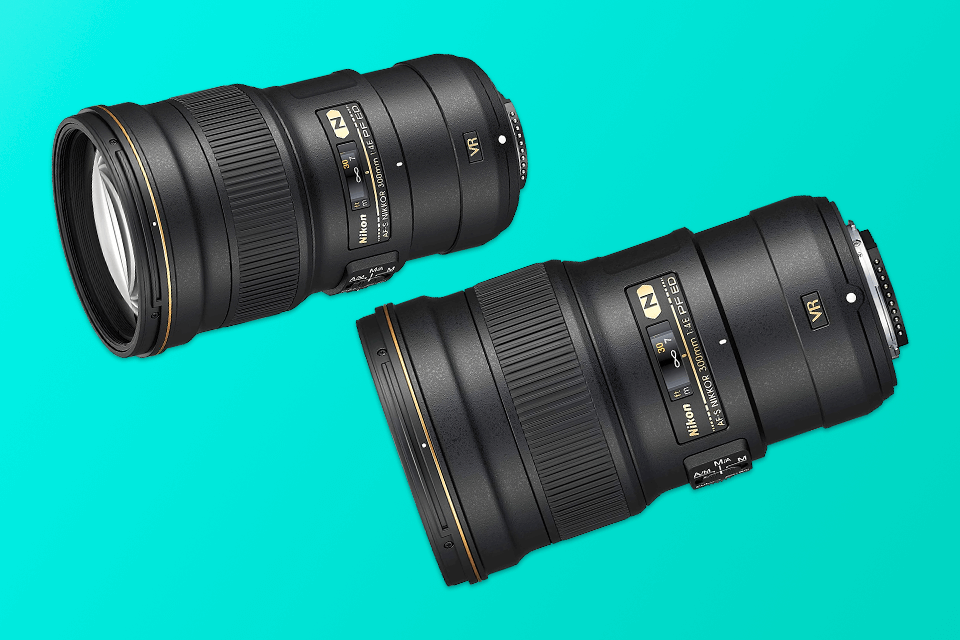
When searching for the Nikon telephoto lens, pay close attention to swift and efficient focusing. It is a significant parameter in particular for those involved in sports and action photography. A supersonic or ultrasonic motor contributes to noiseless and quick focusing.
Besides, decent telephoto lenses are supposed to provide a number of settings on the physical lens. One of such settings is a focus limiter that focuses on subjects within a particular range/ from a particular distance and farther. As a result, the camera won’t spend much time tracking across the long focus range of the lens.
The best telephoto lenses for Nikon should offer picture stabilization. With the use of motors, this feature offsets camera motion and shake during handheld shooting.
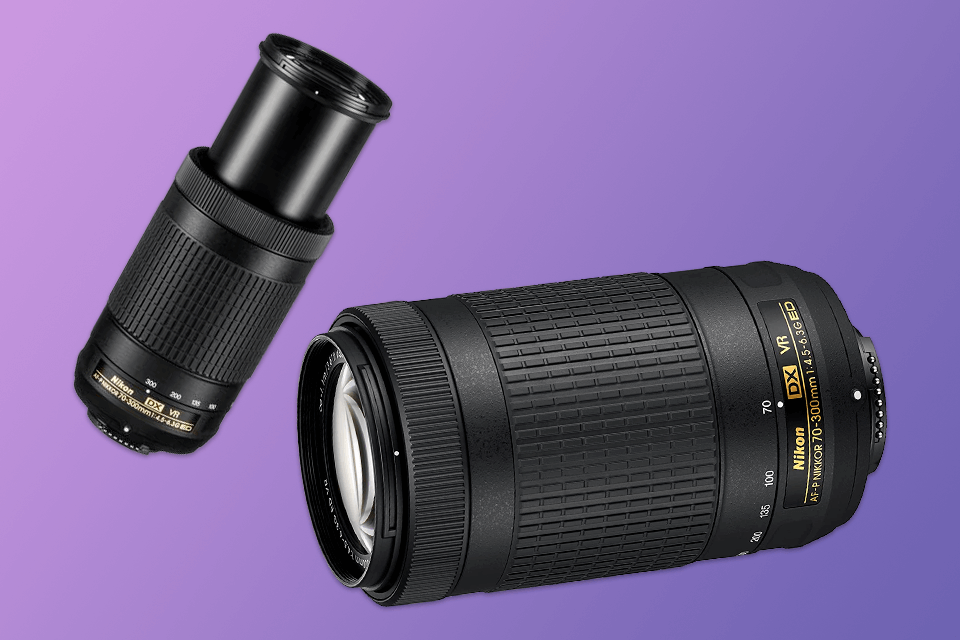
Aperture is another no less significant parameter. In fact, the majority of super-telephoto lenses can’t boast of incredibly fast apertures. Even with the fastest aperture, the lens is likely to be bigger and sold at a higher price than more conventional models.
If quality is a priority, stick to the value of f/2.8. Still, you should decide on what exactly you need and how you will handle hiking with a bulky 8lb or a 3lb lens.
A telephoto lens is meant for photographing subjects located far away from you and events happening at a distance. Portrait photographers take advantage of such lenses as well.
For instance, the AF Zoom-NIKKOR 70-300mm f/4-5.6G is a universal and lightweight lens for photographers who are after telephoto zoom at a budget price. Having a 300mm maximum focal length (corresponding to 450mm on DX-format cameras), the lens will get you closer to the subject you are interested in. Pick this lens if you often take sports, travel and candid shots.
Its long focal length costs much to make, mainly due to the glass components required for the construction of the lens. Besides, a telephoto lens is a much sought-after type among many photographers.
Such a lens will assist you in situations when you need to take shots of the subjects located at a considerable distance. It is especially relevant in case you can’t or don’t want to get closer to these subjects physically. Moreover, if you slightly distance yourself from the person you are photographing, they will feel less tense in front of the camera.

 Rating
Rating